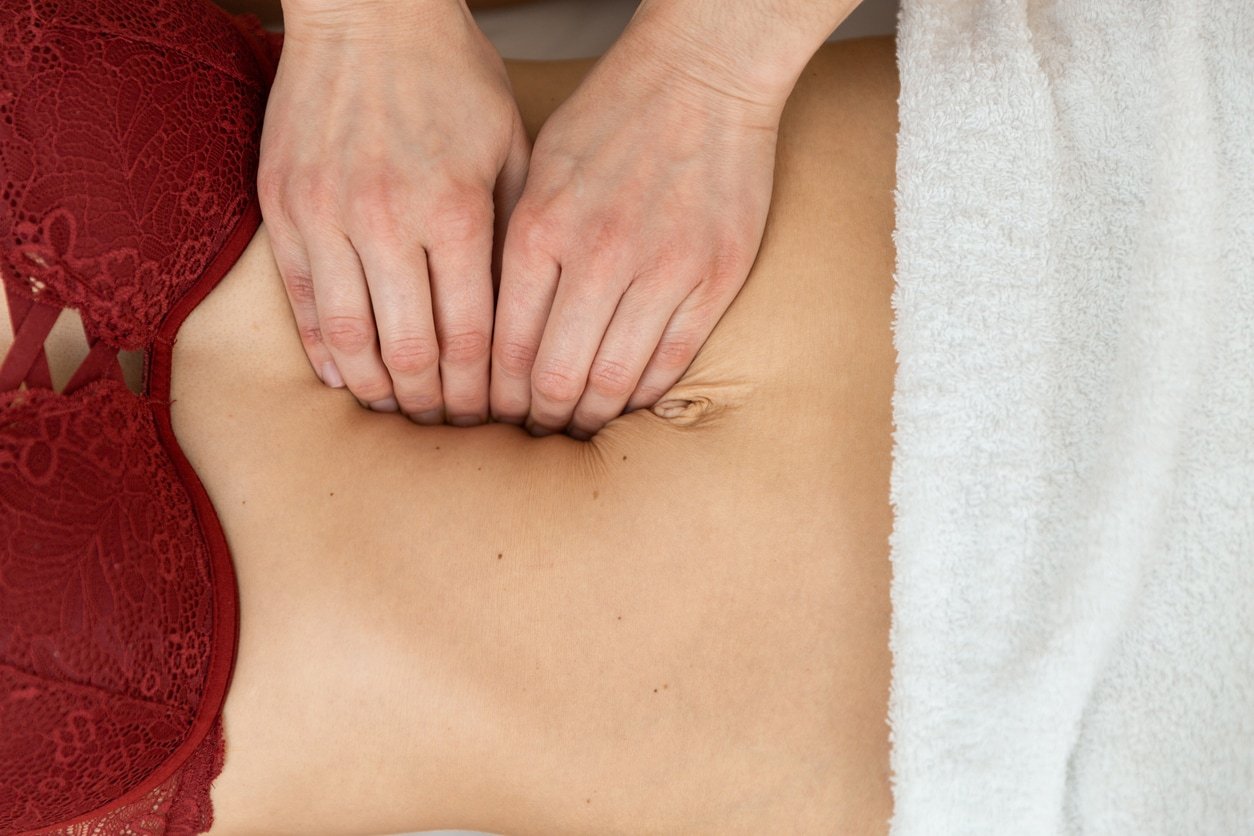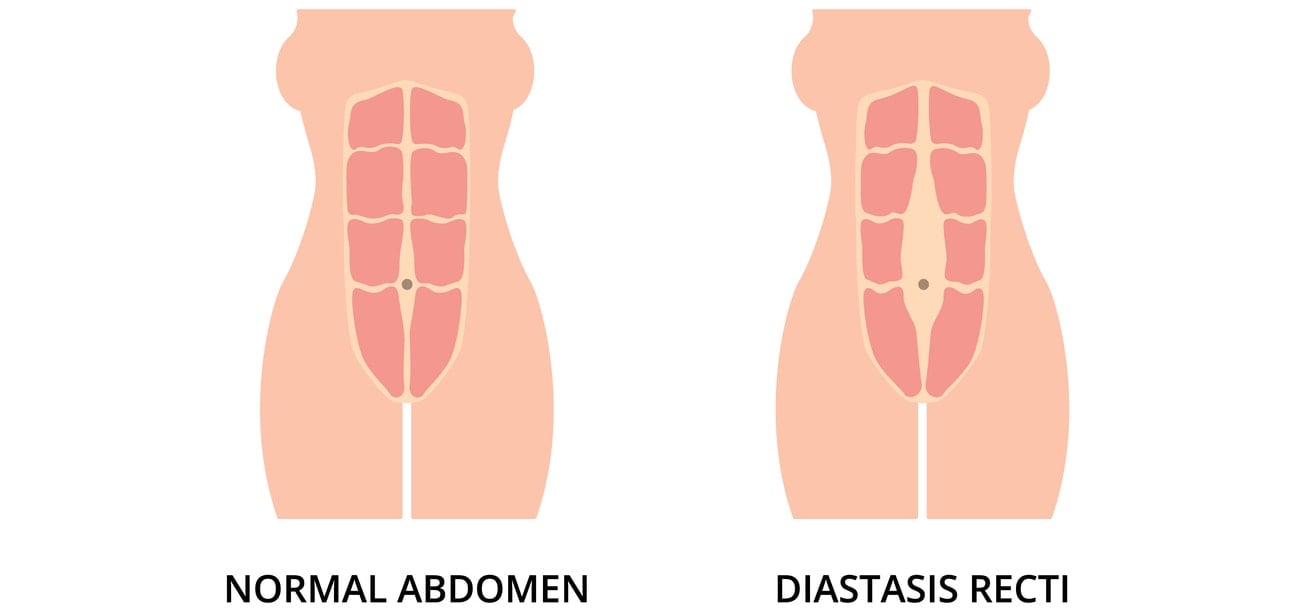
The infamous “mom pooch” can make moms feel as if they look pregnant long after they have delivered their babies. While it may sound superficial to be worried about a small bulging belly postpartum, it is a legitimate medical condition called diastasis recti.
Diastasis recti affects more than just your self-image and confidence; it can cause symptoms from pain to balance issues and more. Fortunately, it is usually diagnosed and treated easily. We will examine the condition, its causes, symptoms, prevention, and treatment.
What Is Diastasis Recti?

Your “six pack” comprises two columns of abdominal muscles called the rectus abdominis. They run vertically from your ribs to your pubic bone. The linea alba is a band of tissue that separates the left and right sides. When these two columns of abs separate and the linea alba widens, this is called diastasis recti. This usually happens due to increased intra-abdominal pressure, such as during pregnancy.1
While there is always some degree of separation between the rectus abdominis muscles, diastasis refers to an abnormal degree of separation.2 Many experts consider separation of more than two centimeters abnormal. However, diagnosing diastasis recti depends just as much on symptoms as the numerical distance.1
How To Check for Diastasis Recti
Diastasis recti can usually be diagnosed with a simple test. You might even identify it on your own. Lie on your back with your knees bent and feet on the floor, lift your shoulders off the ground, and notice the shape of your belly. If you have abdominal separation, you might see the vertical center line between your abs bulges. You might also be able to feel a significant gap between your abs.3
If you suspect you have diastasis recti, your provider can examine you. They may palpate or feel your abdomen in different locations — above, at, and below your belly button. They may use their fingers to measure the gap, or they may use a tool called a caliper to get a more precise measurement. Sometimes, they may use an ultrasound to observe the abdominal gap.2,3
How Common Is Diastasis Recti?
Diastasis recti is very common during pregnancy and postpartum. Some sources report that around 60% of women are affected by it.3 However, exact percentages can be hard to identify because experts and practitioners use different diagnostic and cutoff values.2
For example, even if two centimeters is the universal threshold, is this in a flexed or relaxed state? And is the separation measured above, at, or below the belly button? It is also important to remember that abdominal separation is common even in women without true diastasis recti, especially above the umbilicus.1
One study had physiotherapists assess diastasis recti in pregnant and postpartum women. They classified diastasis recti into mild, moderate, and severe cases based on fingerbreadths between the recti muscles at, above, or below the navel while performing a crunch.4

If the therapist could see the linea alba protruding during the crunch, this was considered diastasis recti, even if the width of the gap was less than two fingerbreadths.4 Based on these criteria, this study found that 60% of women had the condition at six weeks postpartum, and 33% of women still had diastasis at one year postpartum.4
What Are the Risk Factors for Developing Diastasis Recti?
Little is known for sure about the risk factors, but these are some theories on contributing influences:
- Older maternal age4
- How many babies you have had and how close together they are2,3
- Body mass index2
- Frequent heavy lifting4
- Having a large baby or multiple babies4
- Multiples, like twins or triplets4
Although some of these risk factors may contribute to the development of diastasis recti, it is a common condition and can occur even without any of these risk factors.3
What Causes Abdominal Separation?
Abdominal separation happens during pregnancy because of increased volume and pressure in the abdomen. Your growing baby and uterus stretch the abdominal muscles, so the linea alba widens, thins, and protrudes. The linea alba is elastic and typically shrinks back together after delivery. If the linea alba stretches too much and does not retract after pregnancy, this causes diastasis recti, in which the ab muscles remain separated postpartum.3
Diastasis Recti Symptoms
Diastasis recti often begins during pregnancy as your abs separate to make room for your baby.3 This separation can cause some of the following symptoms:
Feeling of Instability
Diastasis can weaken your abdominal muscles, and your core aids a lot in balance. With a weak core from diastasis recti, you may feel unstable.1,3
Midline Bulge
When the ab muscles are separated, your abdominal center line may bulge, especially under increased abdominal pressure.1 This pouch can sometimes feel soft or jelly-like.3
Coning During Pregnancy
In cases of diastasis recti during pregnancy, your bump may form a point where your abs meet instead of appearing perfectly round. This means that, besides the gap between your abdominal muscles, the linea alba protrudes, especially under pressure. Coning may begin in pregnancy but can persist postpartum, and you should watch for this triangular shape in your abdomen when engaging your core.5
Incontinence
Your core muscles and pelvic floor muscles are interconnected, so separation and weakness in the abdominal muscles can cause the leaking of urine during pregnancy and postpartum.3
Pain
While the abdominal separation should not be painful, the weakening it causes of the abdominal muscles can contribute to pain elsewhere. Core and pelvic floor weakness and instability can lead to pain during sex, back pain, and chronic pelvic and hip pain.1,3
Diastasis Recti Treatment
If you are experiencing these symptoms or have found a wide gap between your abdominal muscles even without other symptoms, you are probably wondering how to fix diastasis recti and bring your core back together. Most of the time, treatment consists of physical therapy exercises for diastasis recti combined with increased bodily awareness. Some people choose to wear abdominal binding devices or pursue surgery, though surgery is rarely necessary.3 Different treatments for diastasis recti are outlined here:
Exercise
If you wonder about working out with diastasis recti, you may find conflicting information about the best way to rebuild core stability. However, certain movements and exercises are essential to regaining core strength and stability. Many sources say that when you have diastasis recti, you should avoid traditional core workouts and poses, such as crunches, plank, downward dog, and boat pose. These can increase abdominal pressure, push ab muscles out, and worsen separation. Many sources also recommend avoiding heavy lifting, and a good rule of thumb is not to lift anything heavier than your baby.3
However, one study demonstrated that curl-ups could strengthen and thicken abdominal muscles without increasing separation.6 The key is to ensure you are performing these diastasis recti exercises properly and with awareness — watch your belly as you do the curl-up to ensure no noticeable protrusion or coning is occurring.6
Another study implemented a deep core stability exercise program that significantly decreased abdominal separation and increased quality of life. The program involved diaphragmatic breathing, Kegel exercises, plank poses, and isometric abdominal contraction.7
A physical therapist who specializes in core and pelvic floor concerns of pregnancy and postpartum may be able to help tailor a core rehabilitation program for you. While diastasis recti physical therapy can sometimes improve the appearance of a midline bulge, it is more effective at regaining the proper function of the ab muscles, regardless of how they appear.1
This means that while you may be looking for a dramatic difference between diastasis recti before and after photos, the more important thing is you regain proper function of your abdominal muscles to improve symptoms such as instability, incontinence, and back and pelvic pain.
Abdominal Binders

Some women wear abdominal binders postpartum to hold their abdomen in place and provide low back support. Wearing a binder can remind you to use good posture and engage your core muscles properly; however, these binders do not strengthen the core or heal diastasis recti.3
Surgery
Surgery can reconstruct, repair, or strengthen the linea alba to decrease bulging.1 It can be performed laparoscopically or open, but it is usually reserved for severe cases that do not respond to therapy.1 Some consider this surgery controversial because it is mostly performed for cosmetic purposes. Diastasis recti may be improved in a “tummy tuck” procedure.8
Those who have had repair surgery may feel dissatisfied if their symptoms or appearance do not improve as they expected. Surgery can also cause complications such as infection, bruising, scarring, and other abdominal damage, and a relapse of the diastasis is also possible.1 If you choose to pursue surgery, you should wait at least two years following childbirth, and you should not be planning for any future pregnancies.8 Surgery is necessary in the case of an umbilical hernia, in which part of an organ pops through the linea alba.3
Can You Prevent Diastasis Recti?
You may not be able to completely prevent abdominal separation during pregnancy, as this naturally happens to accommodate your growing baby. However, you can do things to decrease the severity of the separation and lower your risk of diastasis persisting postpartum:3
Be Aware of Abdominal Pressure
Core-specific exercises like sit-ups and planks can increase belly pressure and cause abdominal separation. These are best avoided after the first trimester of pregnancy. Similarly, heavy lifting of weights or even groceries or toddlers can cause strain. Limit heavy lifting to prevent excessive abdominal pressure. When heavy lifting cannot be avoided, engage your deep core muscles to support your rectus abdominis muscles. Watch your belly for linea alba protrusion during lifting, and modify your motions to decrease coning.3
Log Rolling
One way to avoid undue pressure in your abdomen during pregnancy and postpartum is to log roll when getting out of bed. Instead of doing a sit-up or crunch to rise from a reclined position, roll to one side, then use your arms to press yourself up. Decreasing abdominal pressure in everyday activities like this may help prevent diastasis recti from developing or worsening.3
Diaphragmatic Breathing
Belly breathing engages your core with each breath, releasing pressure and tension. This can help prevent abdominal separation. To practice belly breathing, place one hand on your chest and the other on your belly. Inhale. Your belly should press out while your chest remains stationary.3,9
Exercise
Multiple studies have shown that prenatal and postpartum exercise can reduce the width and severity of the ab gap. This may be because exercise helps you maintain core strength during pregnancy and postpartum and also helps with weight management.10
Healthy Weight Gain
One study found that body mass index and weight gain during pregnancy are related to the development of diastasis recti. Awareness of weight gain during pregnancy and keeping your weight gain healthy may help prevent diastasis recti.2
Is It Ever Too Late To Fix Diastasis Recti?
Fortunately, it is never too late to fix diastasis recti. If it has been years since you have had a baby and you are still dealing with diastasis recti, you might be wondering how to fix it years later. You can almost always repair abdominal separation with the right physical therapy exercises. The same exercises, core engagement, and bodily awareness that can repair diastasis recti in the early postpartum days can improve your diastasis years later.3
After all your body has been through in pregnancy and postpartum, it can be frustrating and disheartening to experience lasting effects on your abdominal muscles. While it can be tempting to jump back into core workouts to sculpt your body and regain strength, this may be counterintuitive. Fortunately, diastasis recti can drastically improve with the right therapy and some time.
from Baby Chick https://ift.tt/FBIrGAc
via IFTTT


0 Comments
Please ,
Don't enter span link ...